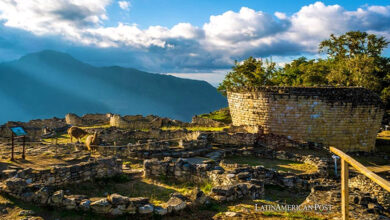Blockchain: Revolutionizing Nature Conservation
Find out how blockchain technology is being used to combat biodiversity loss. From the traceability of species to the financing of protected areas, we explore the challenges and opportunities of this technology.

Photo: Freepik
LatinAmerican Post | Jorge F. Vuelvas Lomeli
Listen to this article
Leer en español: Blockchain: revolucionando la conservación de la naturaleza
The loss of biodiversity is a global challenge that threatens our fauna. In this article, we explore how blockchain technology is being used to address this issue in innovative ways, bringing transparency, traceability, and funding to endangered species protection and protected area management. Despite the technical and legal challenges, the blockchain offers unique opportunities for conservation.
Blockchain and endangered species
Biodiversity loss is a permanent threat to our planet. Species are threatened by habitat degradation, poaching, climate change, among other challenges. However, in the midst of this landscape, blockchain technology is proving to be a powerful tool to address these issues and make a difference in animal conservation.
Such technology, best known for its role in the world of cryptocurrency, is being used to address biodiversity loss in innovative ways. By providing a decentralized and immutable record of data, the blockchain can improve transparency and traceability in the protection of endangered species. Here are several ways it can make a significant contribution:
- Traceability and origin of species. Traceability is a major challenge in the fight against species trafficking. With blockchain, each individual of a species can be traced in a digital record, from its origin to its current location. Such a registry, accessible to anyone on the network, can help verify the lineage and provenance of the species, as well as demonstrate the legality of their possession.
- Smart contracts for conservation. Smart contracts are self-executing code that is activated when certain conditions are met. These can be used to automate processes in the conservation of species. For example, a smart contract could release funds for conservation projects once certain verifiable milestones are reached.
- Real-time monitoring and accurate data. The blockchain can be used to store environmental data collected in real time, such as animal populations or habitat conditions. This data, recorded in the blockchain, is immutable and transparent, which means that it cannot be altered or falsified. This provides a source of accurate information for decision-making in conservation.
An example of an initiative that uses blockchain for the protection of endangered species is the Wildchain platform. This generates digital tokens that represent endangered animals. By purchasing these tokens, users can support conservation projects and gain "token ownership" of a wild animal.
Also read: Environmental Guarantees in the Agreement Between the EU and Mercosur are at Stake
Management of protected areas with blockchain
At the heart of species conservation are protected areas, an essential component to guarantee the survival of our planet's biodiversity. However, these zones often face significant management challenges, ranging from insufficient funding to difficulties in monitoring and controlling activities within the areas. Once again, blockchain technology can offer creative solutions to these challenges:
- Transparent and effective financing. The lack of sufficient funds is one of the biggest challenges for protected areas. The technology at hand can help address this issue through the creation of decentralized crowdfunding platforms. These platforms can use digital tokens to raise funds for the conservation of these areas. Donors can verify how their contributions are used thanks to the transparency of such technology, which increases trust in these projects.
- Community participation. The management of protected areas can be decentralized and democratized through the blockchain, involving local communities in the protection of their natural environment. Local residents can be incentivized with digital tokens to participate in the protection and monitoring of these areas, creating a conservation system that benefits both people and biodiversity.
- Improvement of Governance. The use of smart contracts on blockchain can improve the governance of protected areas. For example, these contracts can automate the allocation of resources or the application of regulations based on accurate and real-time data. This can increase the efficiency and transparency of protected area management.
An example in the management of protected areas is the BioCoin project. This initiative uses digital tokens to incentivize farmers and consumers to participate in the conservation of protected areas, thus promoting sustainable practices and the protection of biodiversity.
Challenges and opportunities of blockchain in conservation
Now, what challenges and opportunities does the use of this technology represent?
Opportunities
- Transparency and verifiability. Blockchain provides an unmatched level of transparency and verifiability, which can enhance trust and cooperation in conservation projects. Traceability of transactions and data on the blockchain can help eliminate corruption and improve the effectiveness of preservation efforts.
- Automation with smart contracts. Smart contracts automate agreements and transactions based on predefined conditions, eliminating the need for intermediaries and reducing red tape. This can speed up and improve the efficiency of conservation processes.
- Incentives with digital tokens. The creation of digital tokens can incentivize participation in conservation and provide a source of funding for conservation projects. This can be especially useful in protected areas, where resources are often limited.
Challenges
- Adoption and technical knowledge. One of the biggest challenges is the lack of knowledge and understanding of the blockchain. For many, it is a complex and esoteric technology. It is essential to increase education and awareness about blockchain so that it can be more widely adopted in conservation.
- Technological infrastructure. The implementation of blockchain technology requires robust technological infrastructure. In many protected areas, especially in developing countries, this infrastructure may be insufficient or non-existent.
- Regulations and legislation. The legal environment around the blockchain is still developing. Regulations can vary widely from country to country, which can make it difficult to implement blockchain-based solutions in conservation.




